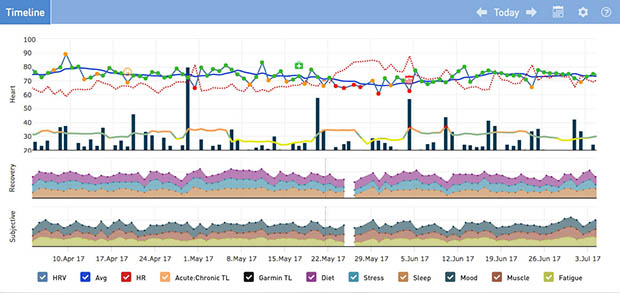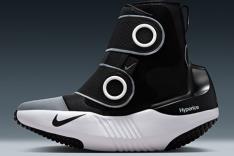6. Variations in readings from day to day is bad.
A certain amount of variation is good, especially if it is created by training. The variation signals disturbance of the body’s normal state (homeostasis), which stimulates adaptation. When daily readings are very close together and around your baseline levels it probably means the body is not getting enough stimulus to adapt.
Experiment with different types of sessions (tempo, HIIT) to see what causes your HRV to dip and then recover within one to two days. If variation from day to day is high without a relation to training it either means other life stresses are dominating (remember Total Load) or your measurement technique is not very consistent.
In addition to HRV, record subjective metrics, comments and flag dates with significant events to unravel the entire picture.

7. Different sensors will produce the same results.
EKG and pulse sensors measure similar things, but they are different enough that they can’t be used interchangeably. Choose a sensor that has been validated independently for HRV (by someone other than the manufacturer!) and stick to it.
Bluetooth chest straps (with the skin contacts well moistened) are a good choice as are finger pulse sensors designed for HRV like those used in hospitals. The important thing is not to regularly switch between different types.
Although we would appreciate the convenience of getting recovery data from a smartwatch, the fact is that the back of the wrist is just not a good location on the body for obtaining precise timing of heartbeats.
8. Measuring on race day will show how recovered and ready to compete you are.
Taking the reading at an unfamiliar location or unusual time plus pre-race nerves will likely distort the reading, making it lower than it would be on a normal day at home. If you get an unexpected orange or red warning, it will mess with your race day head!
On the other hand, a rising HRV trend as you reduce training volume to taper, followed by flattening out of HRV with slightly raised resting HR during taper shows you are both recovered, activated and ready to race. I recommend watching this preceding trend and skipping the reading on race day.
9. High HRV is always better.
Whilst this is often true it is not always true. After intensified training, the body gets tired of producing adrenaline and becomes less sensitive to it, possibly as a mode of self-protection from highly driven type-A personalities! This lowers both your resting heart rate and HR during training, and is often accompanied by higher than normal HRV. Good HRV software will flag unusually high as well as unusually low HRV.
Conclusion
As well as improving the effectiveness of your training and reducing down time to illness and injury, daily measures of HRV can help you learn things about yourself that you didn’t know before, such as how much sleep you really need, how travel affects your recovery, and just how many glasses of wine is one too many!
Just like any metric though, it is not the complete answer, and by recording subjective indicators, flagging significant events such as races and illness as well as looking at training loads through TrainingPeaks, you can build a contextual picture that will enable you to see what works best for you, and keep applying those marginal gains for sustained performance for years to come.
Want to learn more about how to balance your training and recovery through HRV training? Take the TrainingPeaks University online course, “Introduction to Heart Rate Variability” now. Get 20 percent off the cost of the course using code HRVintro2018 at checkout.
 READ THIS NEXT: How to Use HRV to Identify Weaknesses
READ THIS NEXT: How to Use HRV to Identify Weaknesses
Simon Wegerif is a serial entrepreneur, inventor, and biomedical engineer. He was previously an executive with Philips Electronics in the UK and Silicon Valley. Simon is a competitive cyclist and has also completed a number of triathlons including Ironman distance. He created ithlete, the leading, scientifically founded HRV app in 2009 after identifying an opportunity for using HRV in his own training. He is considered an expert on the topic, having read over 1000 papers and frequently consults with industry experts.
- 2
- of
- 2








Discuss This Article